Introduction: Beyond Automation—Navigating the New Frontier of AI-Augmented Content Creation
The rapid proliferation of generative artificial intelligence has triggered a strategic gold rush across industries, with content creation at its epicentre. The market for AI in content creation, valued at an impressive $9.3 billion in 2022, is projected to explode to $47.5 billion by 2030, growing at a compound annual rate of 22.8%. This immense investment is fuelled by the promise of unprecedented efficiency and scale. Yet, a stark paradox lies at the heart of this revolution. A landmark MIT study reveals a “GenAI Divide,” finding that a staggering 95% of generative AI business projects are failing to deliver meaningful revenue acceleration or measurable productivity gains.
This chasm between investment and impact stems from a fundamental misunderstanding of AI’s role in the creative process. Many organizations have adopted these powerful tools not as sophisticated cognitive partners but as autonomous content factories, a misconception that leads to predictable and costly failures. The current landscape is defined by a rush to deploy generic large language models into complex workflows without the specialized adaptation or strategic oversight required for success.
This article deconstructs the five most common and critical mistakes that perpetuate this divide, transforming a powerful asset into a potential liability. It moves beyond tactical tips to present a strategic framework for mastering the human-AI partnership. The analysis will demonstrate that the path to success lies not in replacing human creativity but in augmenting it, transforming AI from a simple assistant into a force multiplier for strategy, originality, and performance.
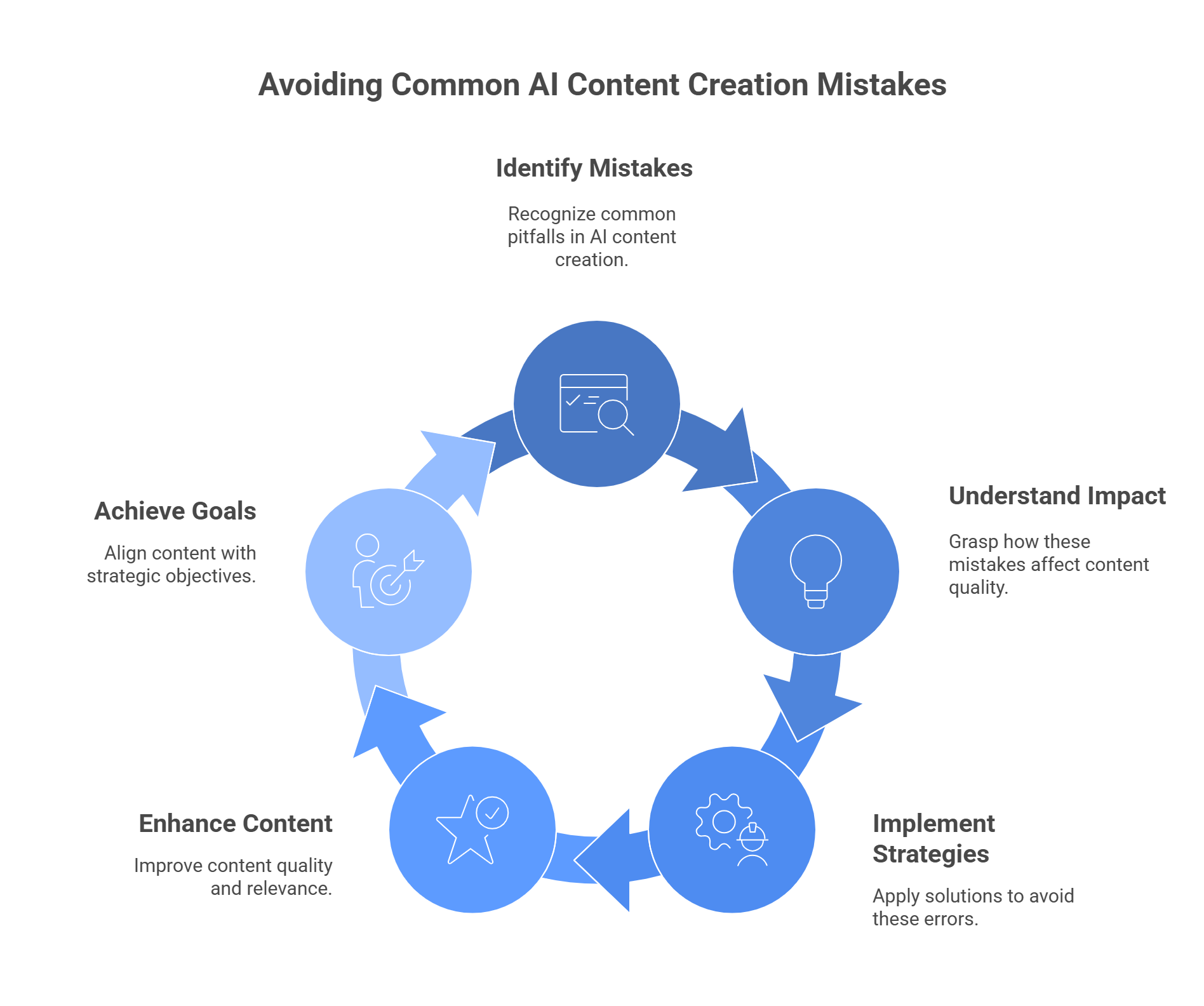
Mistake 1: The “Set It and Forget It” Syndrome: Publishing Raw AI Output Without Rigorous Human Review
The most pervasive and damaging mistake in AI-assisted content creation is treating the initial output as a finished product. The allure of speed leads many to bypass the critical stage of human review, a shortcut that invariably leads to brand erosion, reputational damage, and a decline in content quality. This “set it and forget it” approach is not a time-saver; it’s the industrialisation of brand damage at scale.
The High Cost of Factual Inaccuracy (AI Hallucinations)
A core limitation of large language models (LLMs) is that they are engineered for plausibility, not truthfulness. Their primary function is to predict the next most probable word in a sequence, allowing them to construct sentences that sound correct even when the information they contain is entirely fabricated. This phenomenon, widely known as “AI hallucination,” is a well-documented risk.
The consequences of publishing these inaccuracies can be severe. In one notable case, an AI-generated article for Men’s Health was found to contain 18 factual errors, some of which were “dangerously incorrect” regarding scientific details about testosterone. Similarly, the technology publication CNET was forced to issue corrections on more than half of its initial AI-supported articles after readers discovered blatant plagiarism and factual errors. When a brand publishes false or misleading information, it directly undermines its credibility and erodes the audience’s trust—a foundational component of Google’s E-E-A-T (Experience, Expertise, Authoritativeness, Trustworthiness) quality guidelines.
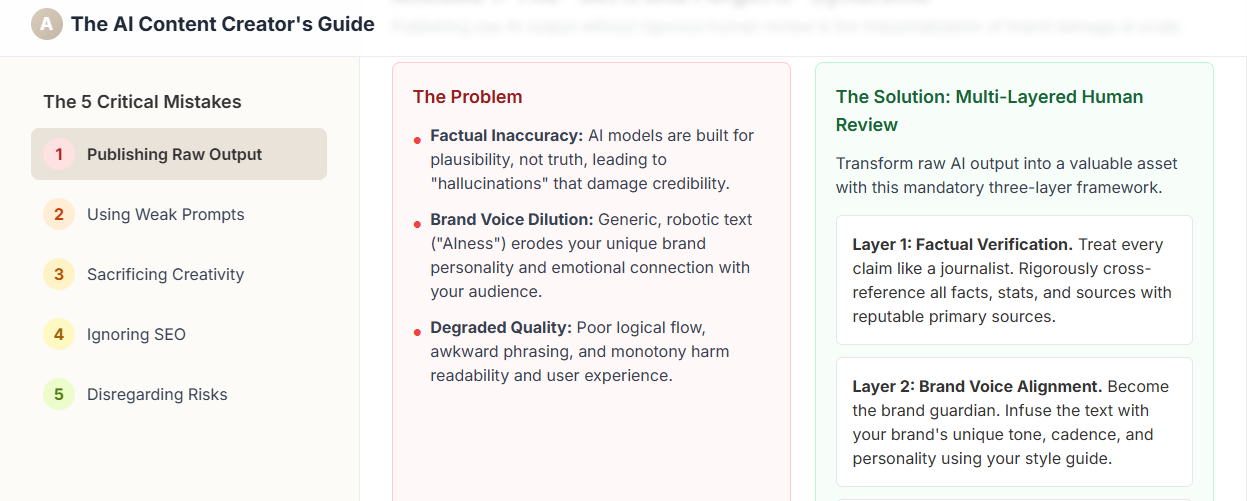
Brand Voice Dilution and the Plague of “AIness”
Raw AI-generated text is notoriously generic, often described as robotic, soulless, and bland. These models tend to rely on a limited set of repetitive phrases and sentence structures, such as “in the realm of,” “dive into,” “landscape,” and “unleash the power of.” This stylistic monotony, often referred to as “AIness,” lacks the unique tone, vocabulary, cadence, and personality that define a brand’s voice.
A brand’s voice is a critical asset, cultivated over years to build recognition and an emotional connection with its audience. When unfiltered AI content is published, this distinct identity is diluted with generic text that could have been produced by any competitor. Over time, this makes the brand forgettable and severs the emotional connection that fosters loyalty.
The Solution: A Multi-Layered Human Review Framework
To counteract these risks, a mandatory, multi-layered human review process is essential. This framework transforms the raw AI output from a liability into a valuable starting point.
- Layer 1: Factual Verification: The first layer of review must treat the editor as a journalist. Every factual claim, statistic, or source generated by the AI must be rigorously cross-referenced with reputable, primary sources to ensure accuracy.
- Layer 2: Brand Voice and Tone Alignment: The second pass involves aligning the text with the brand’s established identity. Editors must review the content against a detailed brand style guide, checking for approved terminology, cadence, emotional tone, and personality. This step is about transforming the text from merely “correct” to truly “authentic.”
- Layer 3: Narrative and Emotional Polish: The final and most crucial layer involves infusing the content with uniquely human elements. This is where editors and writers add storytelling, personal anecdotes, proprietary insights, and empathy. A useful heuristic is the “Coffee Shop Test”: reading the content aloud to determine if it sounds like a natural, engaging conversation one might have with a friend or colleague.
Mistake 2: The Vague Command: Crippling Your AI with Weak and Uninformed Prompts
The quality of AI-generated content is a direct reflection of the quality of the human input. The “garbage in, garbage out” principle is absolute. Vague, lazy, or uninformed prompts are a primary cause of the generic and irrelevant content that plagues many AI-driven strategies. A survey of marketing professionals found that 71% cite generic or bland content as a top concern, a problem that begins with the prompt. Mastering prompt engineering is not a niche technical skill; it is a core competency for any modern content creator.
The Anatomy of a Weak vs. Strong Prompt
An AI model is a literal-minded tool that lacks the ability to infer human intent, context, or unspoken requirements. A weak prompt, such as “Write a blog about cybersecurity,” forces the AI to make broad assumptions, inevitably leading to a surface-level, generic output.
A strong prompt, by contrast, functions as a comprehensive creative brief. It provides the necessary constraints and context for the AI to generate a targeted, relevant, and high-quality response. Interacting with an LLM is analogous to delegating a task to an infinitely knowledgeable but extremely literal junior assistant. A manager would never provide a vague, one-sentence directive to a human team member; they would supply a detailed brief. Applying this same managerial discipline to AI interaction is the essence of effective prompt engineering.
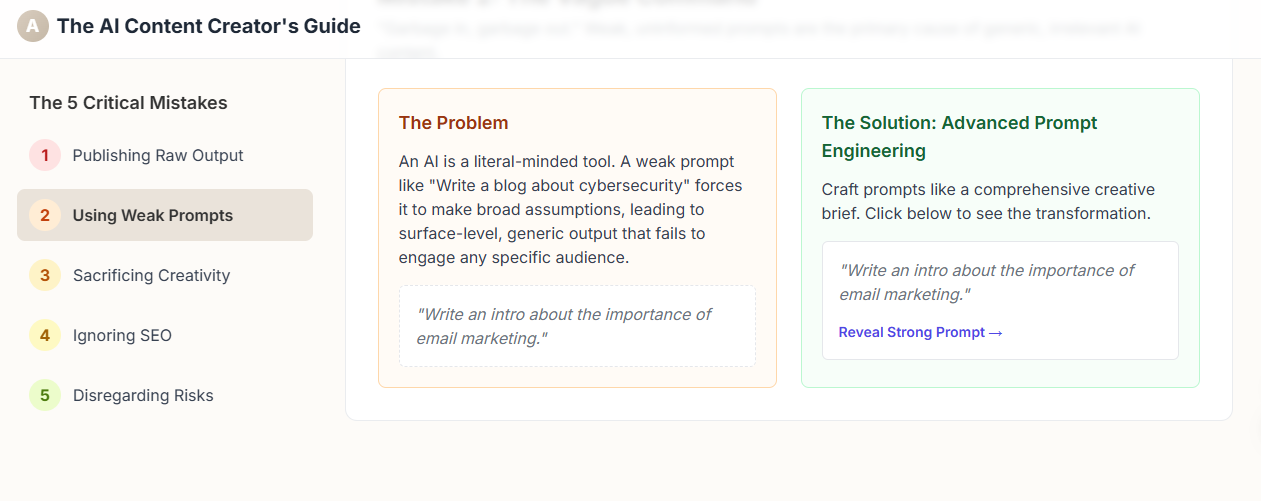
The Solution: A Practical Guide to Advanced Prompt Engineering
Crafting the perfect prompt is an iterative process. The initial output should be seen as a starting point for refinement through a conversational exchange.
- The Iterative Process: Effective prompting often involves a “chain-of-thought” approach, where the creator refines, expands, and corrects the AI’s output through a series of follow-up instructions.
- Breaking Down Complexity: For complex or long-form content, first instruct the AI to generate a detailed outline. Once you approve and refine the outline, prompt the AI to write each section individually for granular control.
- Build a Prompt Library: To scale efficiency, create and maintain a library of your most effective prompts for recurring tasks like generating social media posts, email subject lines, or meta descriptions.
The following table provides a practical demonstration, transforming weak prompts into high-impact instructions.
Content Goal |
Weak Prompt |
Strong, Context-Rich Prompt |
Blog Post Introduction |
“Write an intro about the importance of email marketing.” |
“Act as a seasoned digital marketing strategist. Write a compelling 150-word introduction for a blog post targeting small business owners who are skeptical about email marketing. The tone should be authoritative yet empathetic. Start with a hook that addresses their pain point (e.g., rising ad costs) and conclude by teasing the 3 actionable strategies the post will reveal. Avoid marketing jargon.” |
Social Media Copy |
“Create a LinkedIn post about our new software feature.” |
“Create three distinct versions of a LinkedIn post announcing our new ‘Project Dashboard’ feature for project managers in tech. Version 1: Focus on productivity. Version 2: Use a question to spark engagement. Version 3: Include a short, impactful customer quote. Each post should be under 120 words, include 3 relevant hashtags, and end with a clear call-to-action.” |
Product Description |
“Describe this red t-shirt.” |
“You are a witty e-commerce copywriter for a sustainable fashion brand. Write a 75-word product description for a men’s t-shirt made from 100% organic cotton. The tone is playful and confident. Highlight its softness, eco-friendly credentials, and versatile style for environmentally conscious millennials. Reference this style: ‘Our shirts don’t just feel good, they do good.'” |
Mistake 3: The Ghost in the Machine: Sacrificing Human Creativity, Strategy, and Soul
The third critical mistake elevates the discussion from tactical errors to a profound strategic failure: viewing AI as a replacement for human thought, creativity, and strategy. When organizations over-rely on AI to generate entire pieces of content from start to finish, they are not just automating a task; they are automating mediocrity and abdicating the very responsibilities that create value.
The Automation of Mediocrity and Absence of Emotion
AI models are fundamentally derivative technologies. They operate by analyzing patterns in the vast corpus of existing human-created content, then remixing that information. They are incapable of generating truly novel ideas or unique perspectives that stem from original thought or lived experience. An over-reliance on AI leads to a proliferation of content that is merely a regurgitation of established knowledge, lacking the “creative spark” necessary to capture audience attention.
Furthermore, effective marketing is built on human connection. This requires empathy and emotional intelligence. AI models, devoid of consciousness or lived experience, cannot replicate this. Their output, while grammatically correct, often feels hollow and emotionally detached, preventing the formation of a genuine brand-customer relationship.
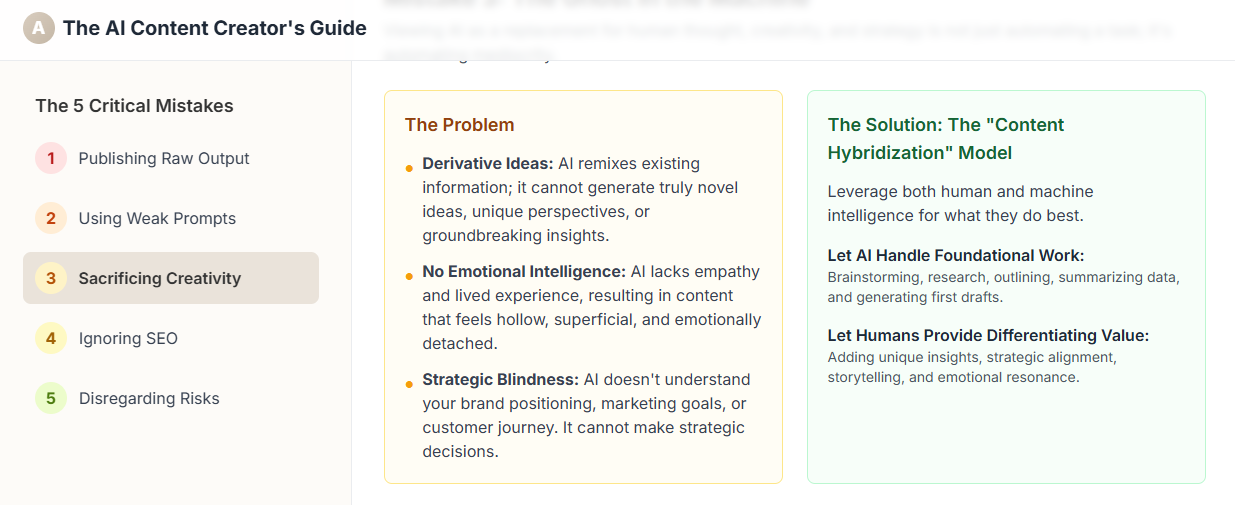
The Solution: The “Content Hybridization” Model
The most effective approach is to adopt a “Content Hybridization” model, which leverages both human and machine intelligence for what they do best. This framework positions AI as a powerful first-draft engine, freeing human creators to focus on irreplaceable, high-value tasks.
- Let AI Handle the Foundational Work: Use AI to overcome the “blank page” and accelerate repetitive tasks. This includes initial research, brainstorming topic ideas, summarizing complex data, creating detailed outlines, and generating foundational text.
- Let Humans Provide the Differentiating Value: The human creator’s role is to take this raw material and elevate it by infusing it with:
- Unique Insights & Lived Experience: Add personal anecdotes, proprietary data, and original case studies that are inaccessible to any AI.
- Strategic Alignment: Ensure the content serves a specific marketing goal, speaks to a defined audience persona, and reinforces the brand’s narrative.
- Creativity & Emotional Resonance: Weave in compelling stories and use evocative language to connect on an emotional level with the reader.
Mistake 4: The SEO Black Hole: Ignoring Search Engine Realities
A common and costly error is to assume that producing more content with AI will automatically lead to better search engine performance. In reality, the indiscriminate use of AI often creates content that is actively detrimental to SEO, as it fails to meet the increasingly sophisticated quality standards of search engines like Google.
The E-E-A-T Disconnect
Google’s quality framework is built on E-E-A-T: Experience, Expertise, Authoritativeness, and Trustworthiness. AI-generated content, by its nature, fundamentally struggles with the “Experience” component. An AI has never used a product, visited a location, or developed a skill through practice. This lack of demonstrable, real-world experience is a significant deficiency. In a world flooded with commodity AI content, E-E-A-T is no longer just an SEO best practice; it is the primary competitive advantage and a “human moat” that defends your rankings.
It is a misconception that Google penalizes content simply because it was created with AI. Google’s official stance is that it rewards high-quality, helpful, people-first content, regardless of its origin. The issue is that AI makes it dangerously easy to produce low-value, spammy content at an unprecedented scale, which Google actively penalizes.

The Solution: An Optimization Framework for AI-Augmented Content
To ensure AI-assisted content performs well in search, it must be subjected to a rigorous optimization framework.
- E-E-A-T Infusion: Enhance the AI draft with genuine, first-hand accounts, original photos/videos, expert quotes, and detailed case studies. Attribute the content to a qualified author with a clear byline and bio.
- Generative Engine Optimization (GEO): Structure content to provide clear, direct answers upfront, following an “inverted pyramid” model. Use conversational, question-based headings and break content into semantically tight, self-contained “chunks” that AI-powered search engines can easily extract.
- Leverage SEO Tools: Utilize specialized platforms like Frase or SurferSEO. These tools can analyze top-ranking competitor content and provide data-driven optimization suggestions to refine your AI-generated drafts.
Mistake 5: The Blindfolded Sprint: Disregarding Critical Legal, Ethical, and Security Risks
The final, and perhaps most overlooked, mistake is the failure to establish a governance framework for AI use. Sprinting to adopt these tools without considering the significant legal, ethical, and security ramifications exposes a business to a portfolio of potentially uninsurable liabilities.
The Copyright Conundrum and Plagiarism Minefield
A fundamental principle of U.S. copyright law is the requirement of human authorship. The U.S. Copyright Office has repeatedly affirmed that works created solely by AI fall into the public domain. This means competitors can legally copy and republish that content without penalty.
Furthermore, models trained on copyrighted material can output near-verbatim excerpts of their training data. When a business publishes this, it can be held liable for unintentional copyright infringement, with statutory damages of up to $150,000 per infringed work. Ignorance—claiming “the AI did it”—is not a valid legal defence.
Data Privacy, Security, and Ethical Breaches
Inputting sensitive company information into a public AI tool can be catastrophic, as the data may be used for model training and is not guaranteed to be confidential. Ethically, AI models can also perpetuate and amplify societal biases found in their training data, causing significant brand damage.
The Solution: A Governance Framework for Responsible AI Use
To mitigate these systemic risks, organizations must move from ad-hoc usage to a structured governance framework.
- Establish a Clear AI Policy: Develop and enforce formal internal guidelines that dictate which AI tools are approved and what data is permissible to input.
- Prioritize Copyright Hygiene: Ensure the final work has been substantially transformed by human creativity. Routinely check outputs with plagiarism detection tools like Copyleaks before publication.
- Educate the Team: Conduct mandatory training on the legal, ethical, and security risks of AI use.
- Disclose When Appropriate: Adhere to a principle of transparency. Disclose the use of AI in content creation when it would be reasonably expected by the audience, thereby maintaining trust and ethical integrity.
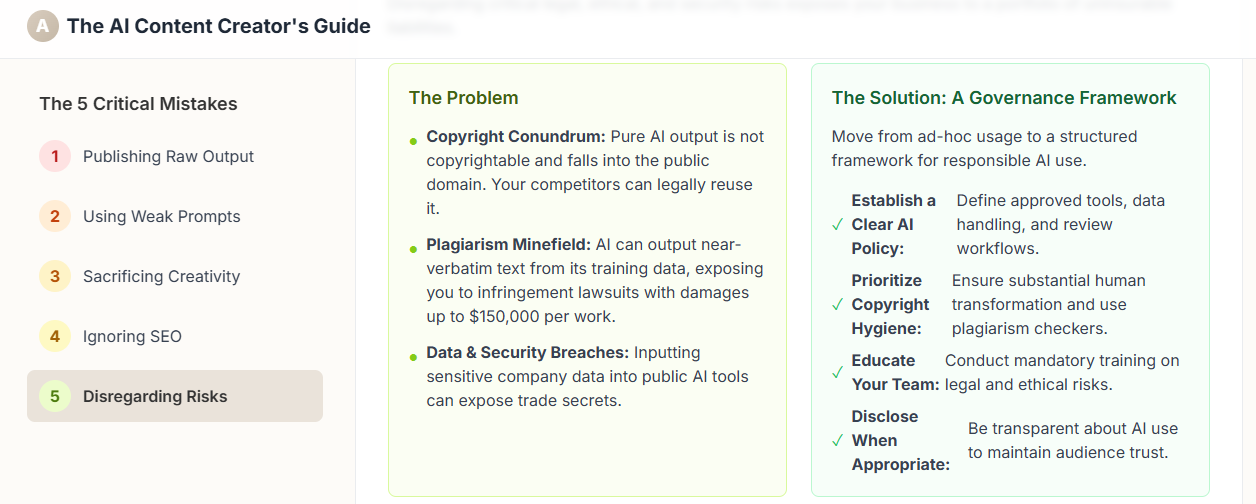
Conclusion: From AI-Assisted to AI-Augmented
The five critical mistakes detailed here are symptoms of a single, flawed paradigm: treating AI as an autonomous creator rather than a powerful, collaborative tool. The path forward requires a fundamental shift from an AI-assisted approach to an AI-augmented one. This human-centric framework redefines the relationship between creator and machine, positioning AI as a force multiplier for human intelligence.
The solutions converge into a cohesive strategy:
- Human-in-the-Loop is Non-Negotiable: Mandatory human review is the ultimate safeguard for quality, accuracy, and brand integrity.
- Briefing is the New Craft: Mastering prompt engineering is what separates generic output from targeted, high-value content.
- AI for Scale, Humans for Value: Delegate foundational tasks to AI. Reserve human talent for original insights, strategic decisions, and emotional connections.
- Authenticity is the Ultimate Ranking Factor: Demonstrable E-E-A-T is the most durable competitive advantage in a synthetic world.
- Govern Before You Generate: Proactive legal, ethical, and security guardrails are the foundation for sustainable innovation.
Ultimately, mastering AI in content creation is not about replacing writers and strategists. It is about creating a new breed of “AI-augmented” professionals who can skilfully orchestrate human and machine intelligence. These individuals will leverage this partnership to produce content and achieve results that neither human nor machine could accomplish alone.


